As you walk into the first room proper at the Royal Academy’s Main Gallery, you are confronted with the lasting achievement of Jasper Johns’ long career: his beguiling, polychromatic, political Flag (1967). Johns’ first flag was completed in 1954, allegedly after a dream, and this painting is a reproduction of a flag, and yet a flag itself; it remains tricky to adequately pin down despite its immediate simplicity. Is this a patriotic revision (perhaps unlikely, although Johns had recently been a serving soldier), or a musing on lost meanings amidst endless reproduction and reproducibility? The series of paintings depicting flags have lost none of their urgency, little of their enigmatic playfulness, and still test our ability to distinguish between art as something, or a representation of something outside of itself. His work speaks to the sense that truth is never certain or static, especially for things like nationhood, but is instead filtered through the subjectivities and perceptions of different people at different times and in ways that resist a referential causality. Johns introduces these complicated ideas in a self-assured yet vernacular style unmatched by any of the American avant-gardists working in the latter half of the 20th century.
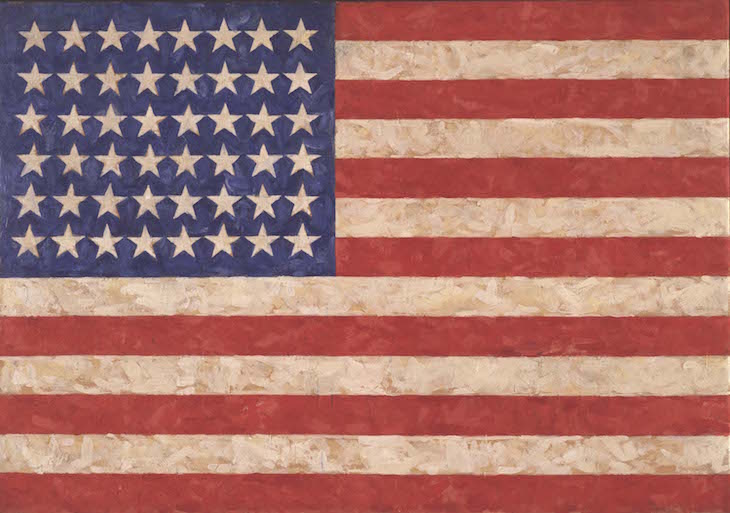
Flag (1958), Jasper Johns. Private collection. Photo: Jamie Stukenberg, © The Wildenstein Plattner Institute, 2017; © Jasper Johns/VAGA, New York/DACS, London 2017
The exhibition’s title takes its name from a statement made by Johns in 2008, as he reflected on the relationship between his work and authenticity: ‘One hopes for something resembling truth, some sense of life, even of grace, to flicker, at least, in the work.’ With Johns’ emphasis on resemblance, not the thing itself, and flickers, not fixed presences, you can see why the title was an appropriate one for the RA’s show. The exhibition is the first major survey of Johns’ work in Britain for over 40 years, in the city that helped make his name, and includes more than 150 paintings, prints, drawings and sculptures. It comes only a few months after the RA’s blockbuster ‘Abstract Expressionism’, which focused on post-war American art. You can tangibly feel Johns wrestling with this legacy in his early paintings, rethinking what an authentic artistic practice might be after the formal seriousness that defined the previous generation.
In his early works, Johns built up a richly textured application of paint on canvas, using the ancient technique of Encaustic to layer as impasto, delighting in how the wax affixed itself far quicker than commonly used oil paints. He chose as his subjects instantly recognisable flat objects – be they maps, flags, Arabic numerals, or shooting targets. They all serve their original function, give or take, insofar as one can find Georgia or Massachusetts on one of the flags, or practice one’s aim on a target. He called these works the ‘things the mind already knows’, part of the catalogue of images one builds from childhood. Johns painted them over and over again, sometimes repeating or layering the same image on top of itself in a single work, testing the limits of resemblance between the object represented and each iteration of that object on the canvas.
Johns made repetition his modus operandi, however imaginatively altered or recuperated, and it can get a little, well, repetitive. An unforgiving visitor might even say that the arc of Johns’ career became paralysed somewhere in the mid 1970s, and much of his work after has little new to say about the issues that preoccupied him then: mechanical reproduction, the limits of signs, nationhood, consumer culture, sexuality. That said, there are certainly paintings to enjoy from his later period, and the exhibition’s thematic approach lends itself to juxtaposing artworks sharing the same focus in each section, demonstrating how Johns’ ideas were recontextualised over his 60-year career.
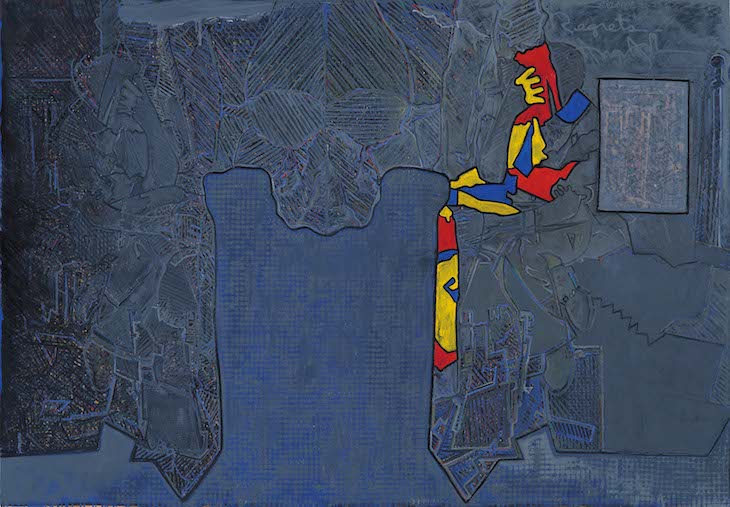
Regrets (2013), Jasper Johns. Collection of Marguerite Steed Hoffman. Photo: © Jerry L. Thompson; © Jasper Johns/VAGA, New York/DACS, London 2017
In the Regrets paintings (2013–14), which return Johns to representing or commemorating remembered experience, he takes on post-war London bohemia. These aquatint on chine-collé works are based on a photograph staged and shot by John Deakin, commissioned by Francis Bacon, that sees Lucian Freud brooding on a decrepit bedspread. In Johns’ rendering, given that Freud is all but obscured by the sensual texture of the jagged lines and colour-against-monochrome contrasts, it doesn’t really feel like a homage to transatlantic kindred spirits. Rather, Regrets meditate on the gap between the memory of an emotion and later action, between the painting’s subject and its own formation. They remain a fascinating series, and are chosen as the final works in the exhibition.
In these paintings we find Johns, as in his earliest works, still interested in the artist as part of a creative community, and in art produced among and featuring friends. More than most, Johns is an artist whom it is practically impossible to see as an individual practicing his craft all alone with his materials (despite the best efforts of one room here entitled ‘In the Studio’). And while there are traces, quite literally, of Johns’ contemporaries in his work – the choreographer Merce Cunningham’s prancing footprint in Numbers (2007) is just one example – we never really get a full sense of the creative and intellectual contexts that were so important to his process.
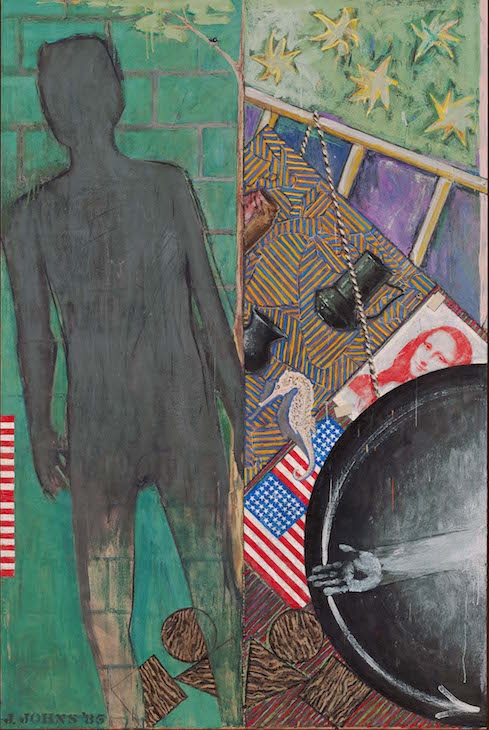
Summer (1985) Jasper Johns. Museum of Modern Art, New York. Digital image: The Museum of Modern Art, New York/Scala, Florence; © Jasper Johns/VAGA, New York/DACS, London 2017
The exhibition would have been strengthened by making more out of his intimate, reciprocal influences: with the composer John Cage, with visionary architect Buckminster Fuller, and especially with his companion Robert Rauschenberg. It is a shame, too, that visitors to the RA are not offered the chance to see Johns’ monumental In Memory of My Feelings – Frank O’Hara (1961), inspired by his friend’s long meditation on furtive identities, that will be on display when the show travels to The Broad in Los Angeles in February. This major work is one of several pieces that demonstrate Johns’ lifelong fascination with poetry, a subject that the exhibition otherwise tackles with poise and depth. Unlike his friend Cy Twombly, who scrawled whole passages of verse onto his canvases, and with whom it is often said Johns formed a ‘triumvirate’ with Rauschenberg, Johns is less interested in the expansive lyricism of poetic meaning, but with the nuts and bolts of language – especially its built-in shortcomings. In Tennyson (1959), named after the Victorian poet laureate, there appears to be little or no engagement with the poet’s verse. Tennyson’s name is merely stencilled at the foot of the painting, propositioning the viewer to mix their own associations with the man, the poet, or his poetry with the rest of the painting. The name ‘Tennyson’ does Johns’ work for him.
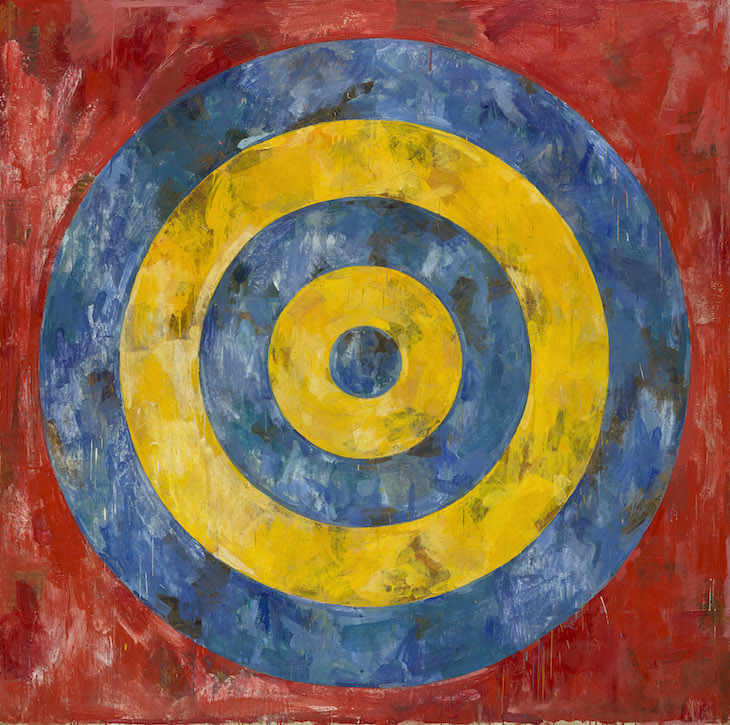
Target (1961), Jasper Johns. Art Institute of Chicago. Photo: © 2017. The Art Institute of Chicago/Art Resource, NY/Scala, Florence; © Jasper Johns/VAGA, New York/DACS, London
The use of stencilled words here and elsewhere draw connections with Ludwig Wittgenstein’s Philosophical Investigations, which the artist first read in 1961, revealing Johns’ similar enquiry into the adequacy of language to represent its subject. The gaps between common language and subjective meaning are also a concern of Samuel Beckett: there is a painting by Johns bearing the playwright’s name as the title, and the pair’s 1976 collaboration on the artists’ book Foirades/Fizzles is one of the pleasures of this exhibition. ‘Jasper Johns: Something Resembling Truth’ might have its flaws, but it is an exhibition that balances the complexities of an enigmatic artist for whom simplicity was his medium, if not his message.
‘Jasper Johns: Something Resembling Truth’ is at the Royal Academy of Arts, London, until 10 December.
Unlimited access from just $16 every 3 months
Subscribe to get unlimited and exclusive access to the top art stories, interviews and exhibition reviews.

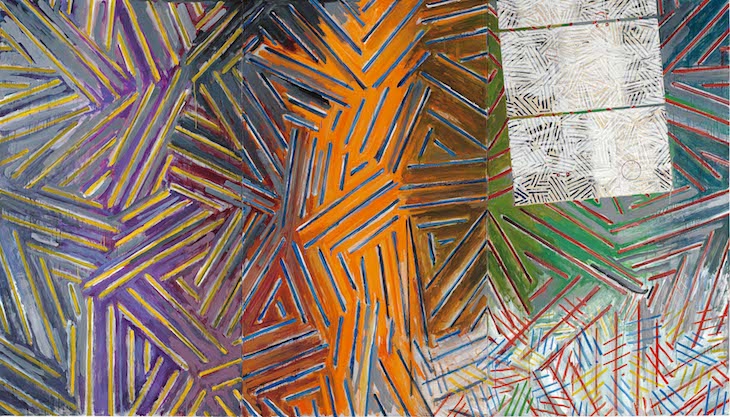

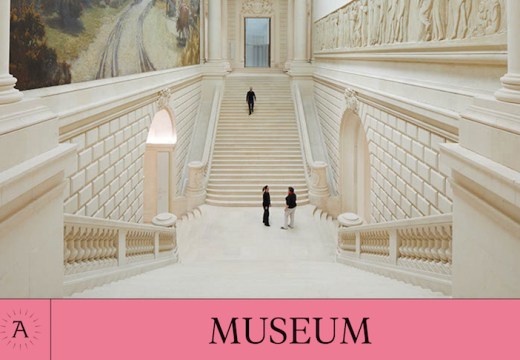










![Masterpiece [Re]discovery 2022. Photo: Ben Fisher Photography, courtesy of Masterpiece London](http://www.apollo-magazine.com/wp-content/uploads/2022/07/MPL2022_4263.jpg)
It’s time for the government of London to return to its rightful home